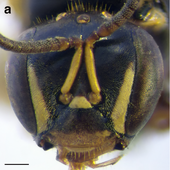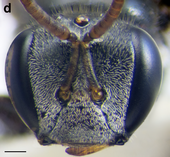
Apidae is the largest family within the superfamily Apoidea, containing at least 5700 species of bees. The family includes some of the most commonly seen bees, including bumblebees and honey bees, but also includes stingless bees, carpenter bees, orchid bees, cuckoo bees, and a number of other less widely known groups. Many are valuable pollinators in natural habitats and for agricultural crops.
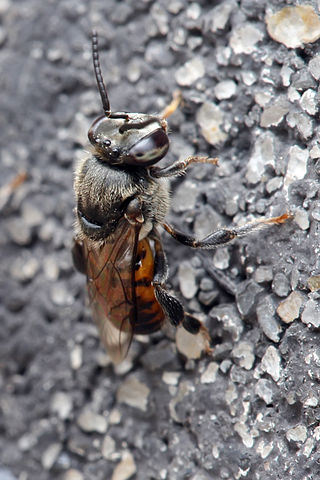
Stingless bees, sometimes called stingless honey bees or simply meliponines, are a large group of bees, comprising the tribe Meliponini. They belong in the family Apidae, and are closely related to common honey bees, carpenter bees, orchid bees, and bumblebees. Meliponines have stingers, but they are highly reduced and cannot be used for defense, though these bees exhibit other defensive behaviors and mechanisms. Meliponines are not the only type of bee incapable of stinging: all male bees and many female bees of several other families, such as Andrenidae, also cannot sting. Some stingless bees have powerful mandibles and can inflict painful bites.

Australia has over 1,700 species of native bee. Bees collect pollen from flowers to feed their young. Flies do not do this, although they may be seen eating pollen, so identification is not always easy.

Schwarziana is a relatively small genus of South American stingless bees. Like other stingless bees, Schwarziana are eusocial, with large colonies primarily composed of workers and one queen. Unusually for stingless bees, colonies are formed in underground chambers rather than in tree cavities. Workers are approximately 6.5mm long

Tetragonula carbonaria is a stingless bee, endemic to the north-east coast of Australia. Its common name is sugarbag bee. They are also occasionally referred to as bush bees. The bee is known to pollinate orchid species, such as Dendrobium lichenastrum, D. toressae, and D. speciosum. It has been identified as an insect that collects pollen from the cycad Cycas media. They are also known for their small body size, reduced wing venation, and highly developed social structure comparable to honey bees.
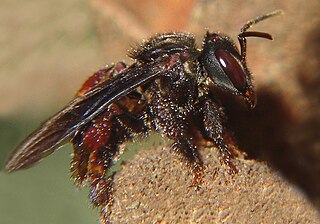
Trigona spinipes is a species of stingless bee. It occurs in Brazil, where it is called arapuá, aripuá, irapuá, japurá or abelha-cachorro ("dog-bee"). The species name means "spiny feet" in Latin. Trigona spinipes builds its nest on trees, out of mud, resin, wax, and assorted debris, including dung. Therefore, its honey is not fit for consumption, even though it is reputed to be of good quality by itself, and is used in folk medicine. Colonies may have from 5,000 to over 100,000 workers.

The Indian stingless bee or dammar bee, Tetragonula iridipennis, is a species of bee belonging to the family Apidae, subfamily Apinae. It was first described by Frederick Smith in 1854 who found the species in what is now the island of Sri Lanka. Many older references erroneously placed this species in Melipona, an unrelated genus from the New World, and until recently it was placed in Trigona, therefore still often mistakenly referred to as Trigona iridipennis. For centuries, colonies of T. iridipennis have been kept in objects such as clay pots so that their highly prized medicinal honey can be utilized.

Trigona corvina is a species of stingless bee that lives primarily in Central and South America. In Panama, they are sometimes known as zagañas. They live in protective nests high in the trees, but they can be extremely aggressive and territorial over their resources. They use their pheromones to protect their food sources and to signal their location to nest mates. This black stingless bees of the tribe Meliponini can be parasitic toward citrus trees but also helpful for crop pollination.
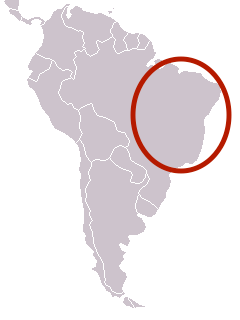
Nannotrigona testaceicornis is a eusocial stingless bee species of the order Hymenoptera and the genus Nannotrigona. Its local common name is abelhas iraí. This species has a large geographic distribution and occupies different biomes, including urban areas, around Neotropical America. The bees of this species nest in trees or artificial cavities because of this broad distribution. N. testaceicornis is important for agriculture because it will pollinate a vast number of plant species year round.
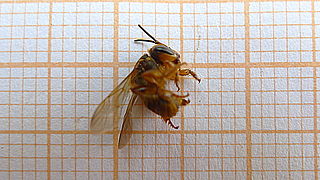
Scaptotrigona postica is a species of stingless bee that lives mainly in Brazil. It is a eusocial bee in the tribe Meliponini. S. postica is one of 25 species in the genus Scaptotrigona and is a critical pollinator of the tropical rain forests of Brazil. They construct their nests in hollowed sections of tree trunks, allowing for effective guarding at the nest entrance. This species shows colony structure similar to most members of the Meliponini tribe with three roles within the colony: queen, worker, and male. S. postica individuals have different forms of communication from cuticular hydrocarbons to pheromones and scent trails. Communication is especially useful during worker foraging for nectar and pollen through the Brazilian tropical rain forests. S. postica is a very important pollinator of the Brazilian tropical rain forests and is widely appreciated for its honey. Stingless bees account for approximately 30% of all pollination of the Brazilian Caatinga and Pantanal ecosystems and up to 90% of the pollination for many species of the Brazilian Atlantic Forest and the Amazon.

Melipona quadrifasciata is a species of eusocial, stingless bee of the order Hymenoptera. It is native to the southeastern coastal states of Brazil, where it is more commonly known as mandaçaia, which means "beautiful guard," as there is always a bee at the narrow entrance of the nest. M. quadrifasciata constructs mud hives in the hollows of trees to create thin passages that only allow one bee to pass at a time. Because they are stingless bees, M. quadrifasciata is often used as pollinators in greenhouses, outperforming honey bees in efficiency and leading to overall larger yields of fruits that were heavier, larger, and contained more seeds.

Tetragonula hockingsi is a small stingless bee native to Australia. It is found primarily in Queensland. The colonies can get quite large, with up to 10,000 workers and a single queen. Workers of Tetragonula hockingsi have been observed in fatal fights with other Tetragonula species, where the worker bees risk their lives for the potential benefit of scarce resources.

Tetragonula is a genus of stingless bees. In 1961, Brazilian bee expert J.S. Moure first proposed the genus name Tetragonula to improve the classification system by dividing the large genus Trigona stingless bees into 9 smaller groups. About 30 stingless bee species formerly placed in the genus Trigona are now placed in the genus Tetragonula. These bees are found in Oceania, in countries such as Australia, Indonesia, New Guinea, Malaysia, Thailand, the Philippines, India, Sri Lanka, and the Solomon Islands. The most recent tabulation of species listed 31 species.

Trigona fuscipennis is a stingless bee species that originates in Mexico but is also found in Central and South America. They are an advanced eusocial group of bees and play a key role as pollinators in wet rainforests. The species has many common names, including mapaitero, sanharó, abelha-brava, xnuk, k'uris-kab, enreda, corta-cabelo, currunchos, zagaño, and enredapelos.
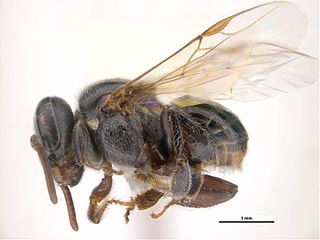
Austroplebeia australis is a stingless bee species in the tribe Meliponini first validly described by Heinrich Friese in 1898. Within Australia, they are occasionally referred to as bush bees.
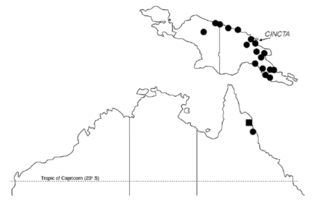
Austroplebeia cincta is a small eusocial stingless bee first described by Mocsáry in 1898 and it is found across Australia and Papua New Guinea.

Austroplebeia cassiae is a small eusocial stingless bee first described by Cockerell in 1910 and it is found in Australia.
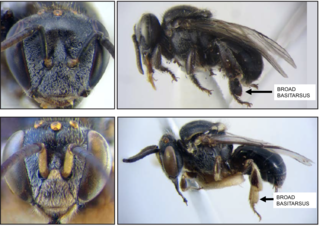
Austroplebeia magna is a small eusocial stingless bee first described by Dollin, Dollin and Rasmussen in 2015 and it is found in Australia.
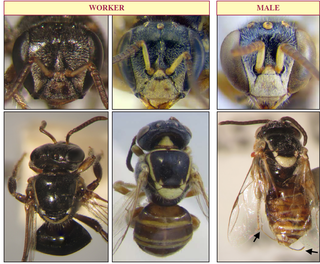
Austroplebeia essingtoni is a small eusocial stingless bee first described by Cockerell in 1905 and it is found in Australia. They are one of the smallest stingless bees in Australia and can survive in very arid areas with annual rainfalls down to 300 mm.

Tetragonula mellipes is a small eusocial stingless bee first described by Friese in 1898 and it is found in Northern Australia.

